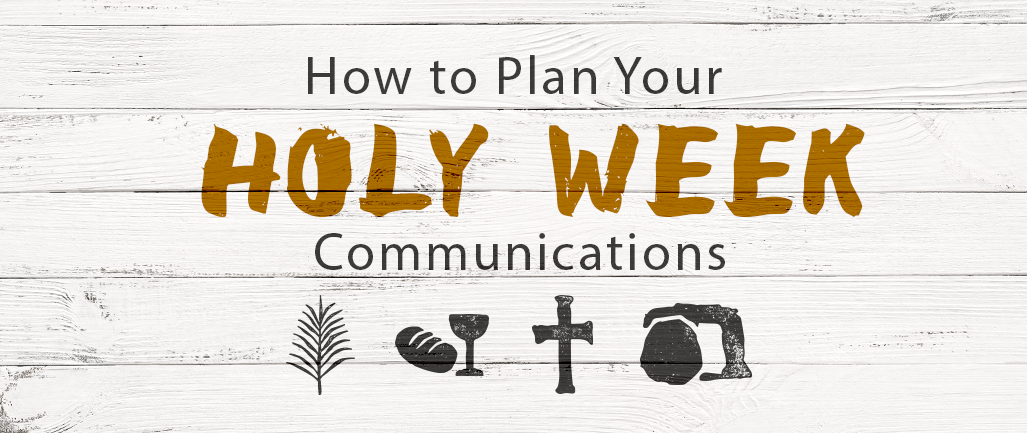
A consistent communications campaign has the power to inspire immediate recognition. It’s like hearing those first notes of a song on the radio while you scan through the stations. Just one a few seconds of the song (or one glance of your communications) can be enough to remind people of the bigger picture!
Creating a coordinated set of website banners, emails, social media posts, and more might sound like a lofty goal for Holy Week, since it’s right around the corner. But doesn't have to take a ton of extra work!
It’s not too late to start planning for Holy Week. I’ve created easy templates to get you started as you plan your content (including templates for website banners and Facebook and Twitter covers), which are in the free marketing kit you can download at the end of this post.
In my opinion, a little planning not only improves your content, but also streamlines your work flow. Here are the steps I follow when planning content for a new communications campaign:
Step 1: Define Your Goal
You (and your team) can start by defining the goal of your Holy Week communications.
Let’s say your goal is to get people (members and visitors alike) to learn more about Holy Week so that they better understand Christ's journey to the cross.
To achieve this objective, we want people to attend worship services on Palm Sunday, Maundy Thursday, Good Friday, and Easter Sunday. So we’ll create a campaign with a consistent look and feel that keeps to those worship service times front and center.
Step 2: Make a Schedule
Make a list of the communications will be part of your campaign. These can include emails, social media updates, website updates, bulletin ads, etc. Decide what role each piece will play in achieving your goals and schedule when each item will go out.
Step 3: Coordinate the Message
Start by taking a little time to brainstorm your message. I like to sit down with an open Word doc and just start writing copy for lots of different communications platforms.
Think of possible tweets, blog post ideas, bulletin blurbs, you name it. By writing out your message in its various forms all at once, you will likely see places where your wording becomes redundant (I can take Y and Z out of the Facebook post since it links to the website, which has that information . . . ), plus, you’ll save time in the long run, since you’ll have that copy ready and waiting when you need to it.
Step 4: Choose Consistent Visuals
Using consistent visuals is very powerful. Our brains are much more likely to notice the “branding” of a campaign when the same image is used in each piece or when they all seem to match one another. I start by imagining all of the different situations where I need to use the image and also how much text needs to fit in with it.
Lots of text? Maybe graphics and a simple background will be best. Dramatic image with minimal copy? Great, let’s find photos that work well together. Editing inconsistent photos is another option; try applying a filter or adjusting them to be black & white to make it look more like a group.
Step 5: Prepare Communications Early
Put those visuals and pre-written copy to good use by making your various communications now rather than later. If you create many of the elements early and at the same time, you’ll find it’s so much easier to keep things consistent (both visuals and words), plus you’ll be much more efficient! Save all of the resources on a network server or in a cloud storage system so that you and anyone else on the team can easily access files and copy when needed.
Bonus: Point to Additional Content
In order to capture their attention (and bolster their interest in attending those Holy Week services), try linking to educational content in your social media posts that explains a little more about Holy Week. This is also great for people who stumble upon your campaign online but do not live near your church.
- Link to relevant portions of Scripture, such as Matthew 26–28 or these Bible verses.
- Point to blog posts from you, your church, or on another blog you trust. Not sure what to write about? Consider a post explaining why the crowds cheered for Jesus on Palm Sunday but cried “crucify Him!” on Good Friday, or, discuss what the Lord’s Supper means for believers today.
- Are there books on your shelf that would help people dive deeper? Suggest your favorite titles. Offer options, like books for children or young adults like as The Christian Year of Grace or Ordering Our Days in His Peace that can help explain this part of the Church year.
- Link to this educational video about Holy Week:
In the end, your goal is to put the focus on Jesus’ death and resurrection. Following these steps can help you develop a powerful message while still maintaining an efficient work flow. Click below to download this a free marketing kit with website banner and Facebook and Twitter cover image templates.
How do you approach creating a marketing campaign at your church? Let us know in the comments!
Download Your FREE Holy Week Marketing Kit
This free kit includes customizable website banners, as well as Facebook and Twitter cover images in both .jpg and .psd file formats!
























